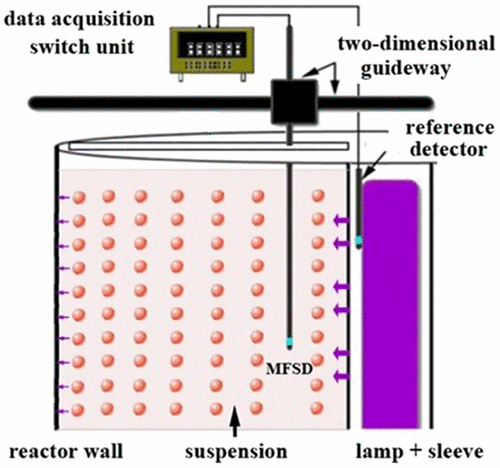当前位置:
X-MOL 学术
›
Environ. Sci. Technol.
›
论文详情
Our official English website, www.x-mol.net, welcomes your
feedback! (Note: you will need to create a separate account there.)
Experimental Evaluation of Turbidity Impact on the Fluence Rate Distribution in a UV Reactor Using a Microfluorescent Silica Detector
Environmental Science & Technology ( IF 10.8 ) Pub Date : 2017-11-03 00:00:00 , DOI: 10.1021/acs.est.7b02730 Mengkai Li 1, 2 , Wentao Li 2 , Dong Wen 2 , Zhimin Qiang 2 , Ernest R. Blatchley 1, 3
Environmental Science & Technology ( IF 10.8 ) Pub Date : 2017-11-03 00:00:00 , DOI: 10.1021/acs.est.7b02730 Mengkai Li 1, 2 , Wentao Li 2 , Dong Wen 2 , Zhimin Qiang 2 , Ernest R. Blatchley 1, 3
Affiliation

|
Turbidity is a common parameter used to assess particle concentration in water using visible light. However, the fact that particles play multiple roles (e.g., scattering, refraction, and reflection) in influencing the optical properties of aqueous suspensions complicates examinations of their effects on ultraviolet (UV) photoreactor performance. To address this issue, UV fluence rate (FR) distributions in a photoreactor containing various particle suspensions (SiO2, MgO, and TiO2) were measured using a microfluorescent silica detector (MFSD). Reflectance of solid particles, as well as transmittance and scattering properties of the suspensions were characterized at UV, visible, and infrared (IR) wavelengths. The results of these measurements indicated that the optical properties of all three particle types were similar at visible and IR wavelengths, but obvious differences were evident in the UV range. The FR results indicated that for turbidity associated with SiO2 and MgO suspensions, the weighted average FR (WAFR) increased relative to deionized water. These increases were attributed to low particle photon absorption and strong scattering. In contrast, the WAFR values decreased with increasing turbidity for TiO2 suspensions because of their high particle photon absorption and low scattering potential. The findings also indicate that measurements of scattering and transmittance at UV wavelengths can be used to quantify the effects of turbidity on UV FR distributions.
中文翻译:

使用微荧光二氧化硅检测器的浊度对紫外反应器中通量率分布影响的实验评估
浊度是用于使用可见光评估水中颗粒浓度的常用参数。然而,颗粒在影响水性悬浮液的光学性质中起多种作用(例如,散射,折射和反射)的事实使检查其对紫外线(UV)光反应器性能的影响变得复杂。为了解决这个问题,在含有各种颗粒悬浮液(SiO 2,MgO和TiO 2的光反应器中,UV注量率(FR)分布使用微荧光二氧化硅检测器(MFSD)进行测量)。在紫外,可见和红外(IR)波长下表征了固体颗粒的反射率以及悬浮液的透射率和散射特性。这些测量的结果表明,所有三种颗粒类型的光学性质在可见光和IR波长处都相似,但是在UV范围内却存在明显的差异。FR结果表明,对于与SiO 2和MgO悬浮液相关的浊度,加权平均FR(WAFR)相对于去离子水有所增加。这些增加归因于低粒子光子吸收和强散射。相反,随着TiO 2浊度的增加,WAFR值降低悬浮液,因为它们具有高的粒子光子吸收率和低的散射潜力。这些发现还表明,在紫外线波长下的散射和透射率的测量可用于量化浊度对紫外线FR分布的影响。
更新日期:2017-11-05
中文翻译:

使用微荧光二氧化硅检测器的浊度对紫外反应器中通量率分布影响的实验评估
浊度是用于使用可见光评估水中颗粒浓度的常用参数。然而,颗粒在影响水性悬浮液的光学性质中起多种作用(例如,散射,折射和反射)的事实使检查其对紫外线(UV)光反应器性能的影响变得复杂。为了解决这个问题,在含有各种颗粒悬浮液(SiO 2,MgO和TiO 2的光反应器中,UV注量率(FR)分布使用微荧光二氧化硅检测器(MFSD)进行测量)。在紫外,可见和红外(IR)波长下表征了固体颗粒的反射率以及悬浮液的透射率和散射特性。这些测量的结果表明,所有三种颗粒类型的光学性质在可见光和IR波长处都相似,但是在UV范围内却存在明显的差异。FR结果表明,对于与SiO 2和MgO悬浮液相关的浊度,加权平均FR(WAFR)相对于去离子水有所增加。这些增加归因于低粒子光子吸收和强散射。相反,随着TiO 2浊度的增加,WAFR值降低悬浮液,因为它们具有高的粒子光子吸收率和低的散射潜力。这些发现还表明,在紫外线波长下的散射和透射率的测量可用于量化浊度对紫外线FR分布的影响。











































 京公网安备 11010802027423号
京公网安备 11010802027423号